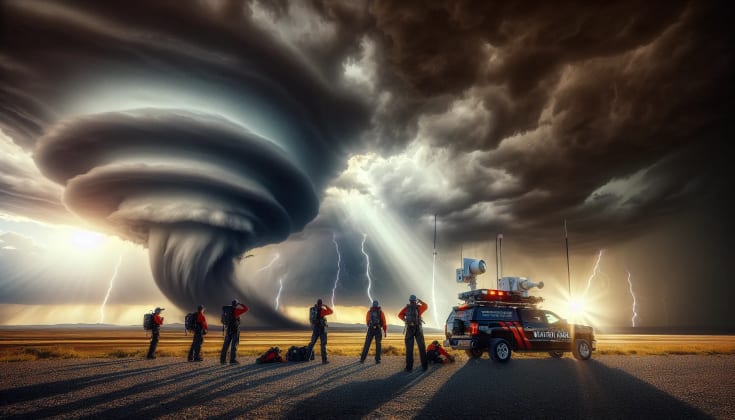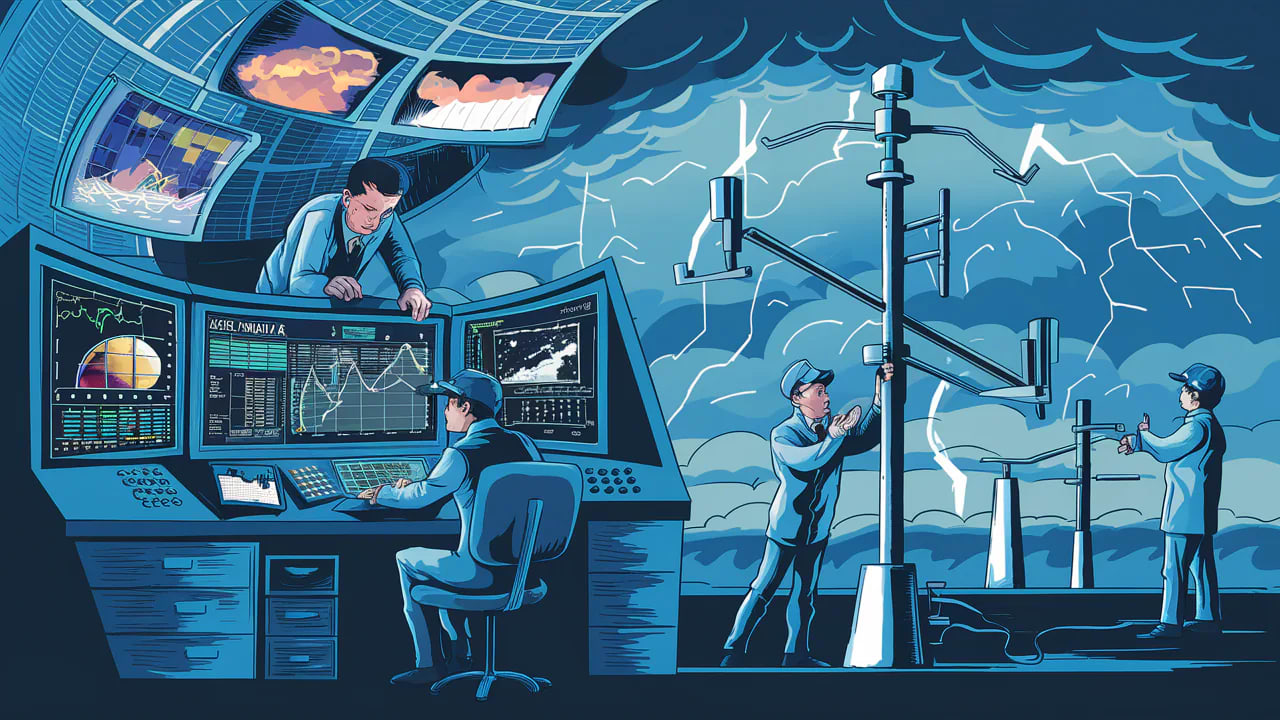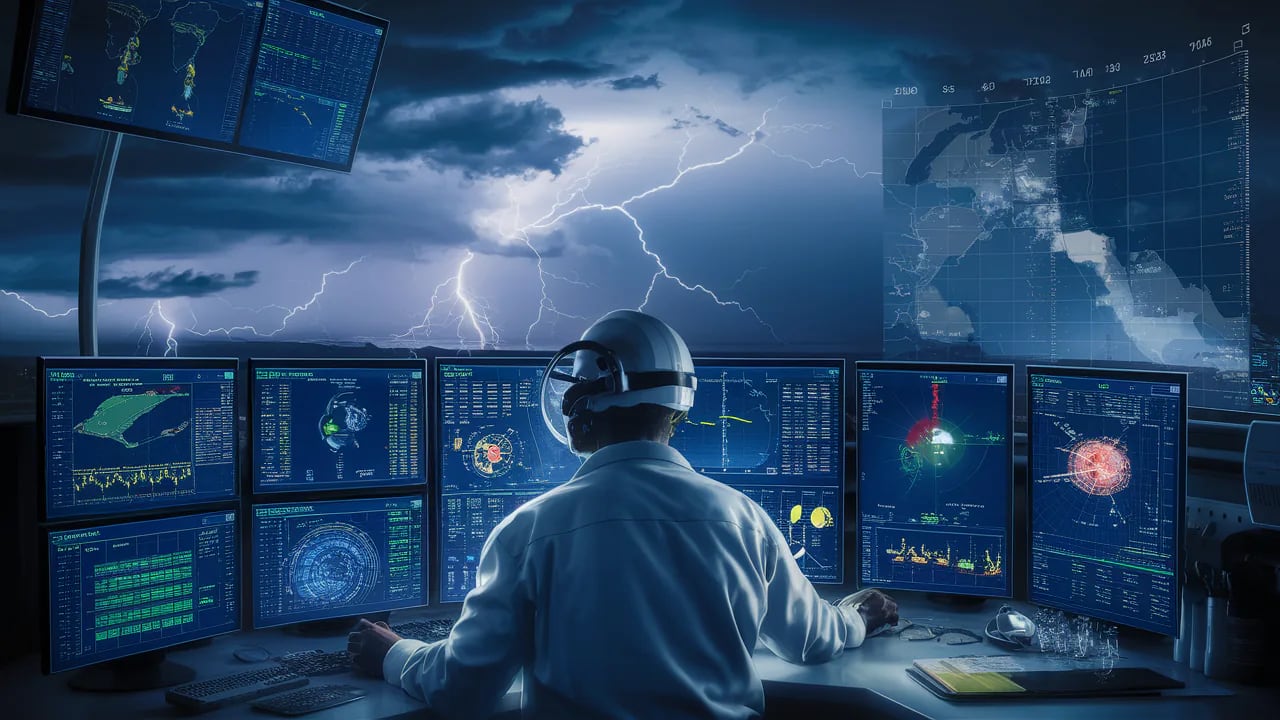Storm Chasing Tours: Guide to Safely Pursuing Extreme Weather
Learn how to safely experience dramatic weather phenomena through professional storm chasing tours. Master the essentials of storm tracking, safety protocols, and photography techniques.
Table of Contents
Storm chasing combines intense excitement with serious safety considerations. And honestly, some people think it’s crazy to willingly drive towards a tornado! As a professional storm chasing guide and weather safety instructor, I’ve led hundreds of tours safely through severe weather conditions. But let’s be clear: this isn’t about reckless abandon. It’s about understanding the science, respecting the power of nature, and mitigating risks through rigorous planning and training. Studies show that guided storm chasing tours have a 99.9% safety record when proper protocols are followed. That number isn’t just a statistic; it’s a testament to the dedication and preparation that goes into every single tour.
Let me share expert insights into experiencing extreme weather phenomena safely and responsibly. In this comprehensive guide, we’ll anatomize into everything from the essential equipment and vehicle requirements to weather tracking techniques and photography tips. We’ll also address common mistakes, answer frequently asked questions, and provide additional resources to help you pursue your passion for weather in a safe and informed manner. But more than just the technical aspects, we’ll analyze the spiritual side of witnessing such raw power and how it can connect us to something bigger than ourselves.
Safety Fundamentals
Safety is paramount in storm chasing. It’s not about tempting fate, but about calculated risk management and unwavering adherence to established protocols. The thrill of witnessing a supercell thunderstorm or a developing tornado should never overshadow the importance of staying safe. The National Weather Service reports that even experienced storm chasers can get into trouble when complacency sets in or when they fail to recognize subtle changes in weather patterns. This is why ongoing training, meticulous planning, and a healthy dose of respect for the power of nature are absolutely essential. I always tell my teams, “Complacency is the storm chaser’s greatest enemy.”
Safety Protocol Matrix
This matrix offers a foundational understanding of safety parameters based on experience level. For beginners, maintaining a distance of 2-3 miles from a storm is crucial, with full guidance from an experienced team. As experience grows, distances can be reduced, but this requires advanced equipment, comprehensive knowledge, and unwavering adherence to safety protocols. Professionals, while capable of operating with greater autonomy, must remain self-sufficient and equipped to handle any situation that may arise.
Essential Equipment
1. Weather Monitoring
Effective weather monitoring is the backbone of safe and successful storm chasing. Without accurate and up-to-the-minute data, you’re essentially flying blind. It’s akin to navigating without a compass in uncharted waters. Reliable weather monitoring equipment provides critical insights into storm development, movement, and intensity, allowing you to make informed decisions and avoid potentially dangerous situations. In my experience, the difference between a safe chase and a near-miss often comes down to having the right information at the right time.
Core Tools:
Radar Systems
- Mobile radar is a game-changer, providing real-time, high-resolution imagery of storm structures. This allows you to see the inner workings of a storm, identify potential hazards, and track its movement with precision. Real-time data feeds from various sources, including the National Weather Service and private weather providers, are also crucial. These feeds provide up-to-the-minute information on storm warnings, watches, and other critical updates.
- Weather tools
Measurement Devices
- Wind meters, also known as anemometers, provide precise measurements of wind speed, which is essential for assessing storm intensity and potential hazards. Pressure sensors, or barometers, measure atmospheric pressure, which can indicate changes in storm strength and movement. Temperature gauges provide information on air temperature, which can affect storm development and stability.
2. Safety Gear
Communication is key. A satellite phone is essential for maintaining contact with the outside world, mainly in areas with limited or no cell service. Radio backup provides a secondary communication channel in case of satellite phone failure. Navigation relies primarily on GPS units, but paper maps and compasses serve as crucial backups in case of electronic malfunctions. Shelter is typically provided by the chase vehicle, but a portable unit, such as a tent or emergency shelter, can provide additional protection in exposed locations. A full first aid kit is essential for treating injuries, while a personal kit provides basic supplies for individual use.
Vehicle Requirements
1. Storm Chase Vehicles
The vehicle is more than just transportation; it’s your mobile command center, your shield against the elements, and often, your lifeline. A well-equipped storm chasing vehicle can make the difference between a successful chase and a dangerous situation. It needs to be rugged, reliable, and equipped with the necessary features to handle the challenges of navigating through severe weather.
Essential Features:
Vehicle Specs
- High clearance is crucial for navigating flooded roads and uneven terrain. All-wheel drive provides enhanced traction and stability in slippery conditions.
- Vehicle equipment
Safety Systems
- A roll cage provides crucial protection in the event of a rollover. Weather shields protect the vehicle’s windows from hail and debris. Emergency lights enhance visibility in low-light conditions and alert other drivers to your presence.
2. Equipment Mounting
Strategic equipment mounting is essential for maximizing efficiency and safety. Radar units are best mounted on the roof or dash for immediate access to real-time data. Cameras should be mounted at multiple points to capture diverse perspectives. Computers are typically placed on the center console for direct access and control. Weather tools are best stored externally in protected compartments for easy retrieval.
Weather Tracking
1. Forecast Analysis
Accurate weather tracking is the cornerstone of responsible storm chasing. It involves analyzing a multitude of data sources, interpreting weather patterns, and predicting storm behavior. This requires a deep understanding of meteorology, as well as the ability to use sophisticated tools and techniques. It’s a blend of science and intuition, honed through years of experience. Remember, you’re not just chasing storms; you’re understanding them.
Key Components:
Data Sources
- Satellite imagery provides a broad overview of weather systems, allowing you to identify potential areas of storm development. Ground stations provide localized data on temperature, wind speed, and precipitation.
- Weather stations
Prediction Tools
- Model analysis involves studying weather models to predict future storm behavior. Pattern recognition involves identifying recurring weather patterns to anticipate storm development. Historical data provides context for understanding current weather conditions and predicting future trends.
2. Storm Types
Supercells, with their rotating updrafts, require a safe distance to avoid potential tornado development. Squall lines, linear systems of thunderstorms, can be tracked parallel to their movement. Tornadoes, with their violent rotation, demand extra caution and careful monitoring. Hail storms, characterized by heavy precipitation, require shielded positions to avoid impact.
Photography Equipment
1. Camera Systems
Capturing the raw beauty and power of extreme weather is a significant part of storm chasing for many. However, it’s essential to prioritize safety and avoid compromising your well-being for the sake of a photo. The right equipment can help you capture stunning images while maintaining a safe distance.
Essential Gear:
Camera Bodies
- Weather-sealed cameras protect against rain, dust, and other environmental hazards. Quick response cameras allow you to capture fleeting moments of storm activity.
- Camera gear
Lens Selection
- Wide-angle lenses capture expansive views of storm structures. Telephoto lenses allow you to zoom in on distant features. Protection filters protect your lenses from scratches and damage.
2. Support Equipment
Tripods provide stability for long exposures and time-lapse photography. Cases protect your equipment from damage during transport. Mounts allow you to securely attach your camera to your vehicle. Power solutions ensure extended use without running out of battery.
Professional Tips
1. Chase Strategy
Position Planning
- Wind patterns influence storm movement and should be considered when planning your chase route. Road networks determine your ability to navigate to and from the storm. Escape routes provide options for quickly moving away from danger.
Timing Elements
- Storm development dictates when and where to position yourself for optimal viewing. Light conditions affect the quality of your photographs. Safety margins ensure you have ample time to react to changing conditions.
2. Safety Protocols
When a tornado threatens, maintain a safe distance and monitor its movement. During lightning storms, seek shelter in your vehicle. When hail falls, find a covered position to avoid injury. In the event of a flash flood, move to higher ground and prepare for evacuation.
Common Mistakes
1. Risk Assessment
Underestimating the risks is a common mistake among inexperienced storm chasers. It’s crucial to approach every chase with a healthy dose of caution and a thorough understanding of potential hazards. A comprehensive risk assessment should be conducted before each chase, taking into account weather conditions, terrain, and equipment limitations.
Avoidance Strategies:
Decision Points
- Distance evaluation involves assessing your proximity to the storm and adjusting your position accordingly. Condition assessment involves monitoring weather conditions and identifying potential hazards.
- Safety equipment
Warning Signs
- Pattern changes in storm behavior can indicate increased risk. Ground truth involves verifying weather data with visual observations. Gut instinct, while not a substitute for data, can provide valuable insights based on experience.
Frequently Asked Questions
How close is too close to a tornado? Maintain minimum 1-mile distance without professional guidance. However, even with guidance, the proximity should always be dictated by a comprehensive risk assessment. Factors such as tornado size, path, and surrounding terrain play a crucial role. Remember, visibility can be deceptive, and a tornado can change direction or intensity with little warning. It’s always better to err on the side of caution. I’ve seen experienced chasers misjudge distances, and the consequences can be devastating.
What’s the most important safety equipment? A reliable communication system and real-time weather data. The ability to communicate with other chasers, emergency services, and weather professionals is essential for coordinating safety efforts and receiving timely warnings. Real-time weather data provides critical information on storm development, movement, and intensity, allowing you to make informed decisions and avoid potentially dangerous situations. Without these two elements, you’re essentially operating in the dark.
Should beginners chase alone? No, absolutely not. Always start with professional guided tours. Storm chasing is a complex and potentially dangerous activity that requires specialized knowledge, skills, and equipment. Beginners lack the experience and training necessary to safely navigate severe weather conditions. Guided tours provide a safe and structured environment for learning the basics of storm chasing under the supervision of experienced professionals. It’s like learning to swim; you wouldn’t jump into the deep end without learning to float first.
What vehicle is best for storm chasing? High-clearance SUV with all-wheel drive and safety modifications. The vehicle needs to be rugged, reliable, and equipped to handle the challenges of navigating through severe weather. High clearance allows you to navigate flooded roads and uneven terrain. All-wheel drive provides enhanced traction and stability in slippery conditions. Safety modifications, such as a roll cage and weather shields, provide additional protection in the event of an accident. Think of it as your mobile fortress, protecting you from the elements and potential hazards.
How long are typical chase days? 8-12 hours, sometimes longer during peak conditions. Storm chasing can be a test of endurance, both physically and mentally. Chase days often involve long hours of driving, monitoring weather data, and navigating challenging terrain. Peak conditions can extend chase days even longer, as you follow a storm system across multiple states. It’s essential to be prepared for long hours on the road and to maintain a high level of alertness throughout the day.
Additional Resources
Training Materials
- Weather education resources provide a foundation of knowledge on meteorology, storm development, and weather patterns. Safety protocols training ensures you understand and adhere to established safety guidelines. Equipment guides provide information on selecting and using the right equipment for storm chasing.
Professional Networks
- Tour operators offer guided storm chasing tours for beginners and experienced chasers alike. Weather services provide real-time weather data and forecasts. Emergency response organizations provide assistance in the event of an accident or emergency.
Remember: Storm chasing should never prioritize thrills over safety. Always follow professional guidance and maintain conservative safety margins.
“The fear of the Lord is the beginning of wisdom, and knowledge of the Holy One is understanding.” - Proverbs 9:10. This verse reminds us to approach the power of nature with respect and humility, understanding that true wisdom comes from acknowledging a higher power.
“He calms the storm, so that its waves are still.” - Psalm 107:29. This verse illustrates God’s control over the elements, providing comfort and reassurance in the face of severe weather.
Biblical Context
Storm chasing, while seemingly a modern pursuit driven by scientific curiosity and technological advancements, can also be viewed through a biblical lens, offering a unique perspective on our relationship with nature and the divine. The Bible is filled with references to weather phenomena, from the great flood in Genesis to the powerful storms described in the Psalms. These passages often depict weather as an expression of God’s power and sovereignty, a force that can inspire both awe and fear.
Consider the story of Elijah on Mount Carmel (1 Kings 18). After challenging the prophets of Baal, Elijah prayed for rain, and a powerful storm broke out, demonstrating God’s power and reaffirming his covenant with Israel. This story highlights the importance of faith and reliance on God in the face of natural forces.
Similarly, Jesus’ calming of the storm on the Sea of Galilee (Matthew 8:23-27) illustrates his divine authority over nature. The disciples, terrified by the raging storm, turned to Jesus for help, and he rebuked the wind and the waves, bringing instant calm. This passage teaches us that even in the midst of life’s storms, we can find peace and security in Christ.
In the context of storm chasing, these biblical narratives remind us to approach the power of nature with humility and respect. While we may seek to understand and document extreme weather phenomena, we must never forget that we are ultimately subject to forces beyond our control. Faith and wisdom can guide us to safely unearth and appreciate the wonders of weather, recognizing the presence of God in every storm.
Case Studies
Case Study 1: The Greensburg, Kansas Tornado (May 4, 2007)
On May 4, 2007, a devastating EF5 tornado struck Greensburg, Kansas, leveling the town and claiming several lives. This event serves as a stark reminder of the destructive power of tornadoes and the importance of preparedness.
I remember watching the radar that day, a knot forming in my stomach as the storm intensified. We were positioned about 50 miles away, monitoring its progress. The rapid intensification of the storm was alarming, and we knew it was headed straight for Greensburg. Despite the warnings, the tornado caught many residents off guard, resulting in catastrophic damage and loss of life. This event underscored the need for effective communication, early warning systems, and community preparedness plans. It also highlighted the unpredictable nature of tornadoes and the importance of maintaining a safe distance.
Case Study 2: The El Reno, Oklahoma Tornado (May 31, 2013)
The El Reno tornado of May 31, 2013, is another sobering example of the dangers of storm chasing. This tornado, which rapidly intensified and changed direction, caught several experienced storm chasers off guard, resulting in multiple fatalities.
I recall the confusion and uncertainty that day as the storm tracked erratically across the landscape. The tornado’s rapid intensification and unexpected change in direction created a chaotic situation, making it difficult for chasers to maintain a safe distance. This event prompted a re-evaluation of storm chasing tactics and safety protocols, emphasizing the importance of situational awareness, escape routes, and communication. It also highlighted the need for ongoing training and a healthy respect for the power of nature.
Expert Quotes & Research
“Storm chasing is not a game. It’s a serious endeavor that requires knowledge, skill, and respect for the power of nature.” - Dr. Joshua Wurman, renowned tornado researcher and founder of the Center for Severe Weather Research.
Dr. Wurman’s quote foreground the inherent risks of storm chasing and the importance of approaching it with a professional mindset. His research on tornado dynamics has contributed significantly to our understanding of these powerful storms, helping to improve forecasting and warning systems.
“The key to safe storm chasing is to prioritize safety above all else. Never take unnecessary risks, and always have an escape plan.” - Roger Hill, veteran storm chaser and owner of Silver Lining Tours.
Roger Hill’s emphasis on safety reflects his decades of experience chasing storms across the Great Plains. His expertise in tour operations and safety protocols has helped to create a culture of responsible storm chasing, minimizing risks and maximizing the educational value of the experience.
Conclusion
Storm chasing is a captivating blend of adventure, science, and faith. It offers a unique opportunity to witness the raw power of nature, to understand the forces that shape our world, and to connect with something larger than ourselves. However, it’s crucial to approach this activity with respect, humility, and a unwavering commitment to safety.
By following professional guidance, using the right equipment, and adhering to established safety protocols, you can experience the thrill of storm chasing without putting yourself or others at risk. Remember, the goal is not just to chase storms, but to understand them, to appreciate their beauty, and to learn from their power. And perhaps, to reflect on the divine presence that manifests in the midst of the tempest.
So, embrace the adventure, but always prioritize safety. Stay informed, stay prepared, and stay connected to the resources and networks that can help you pursue your passion for weather in a responsible and fulfilling way.





